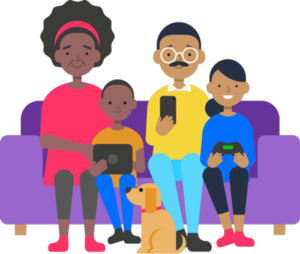Get advice from online safety experts to help children use new digital Christmas gifts safely.
Steps to take if gifting a child their first device
I think there are lots of answers to this question and lots you can do. Much will depend on how your household is already set up.
If your child is about to get their first console or handheld device, make sure that you set out your ground rules right away – and remember it is always much harder to put stronger rules in later, so start fairly strict!
- Spend some time getting to know the ins and outs of the console or device before Christmas morning.
- Know how to use the safety features – you can find lots of useful advice right here on Internet Matters.
- The rules are up to you but I would always strongly suggest gaming or going online in a communal space, not a bedroom, so you can keep an eye on what they are doing.
- Consider a daily time limit (this might be different at weekends or on holidays). There should be a clear cut-off time at night, and devices should always be left outside the bedroom. Studies have shown that the addictive nature of our devices still has hold of us even if they are turned off, or are face down. They need to be well out of the room, so children get enough downtime away from them.
- And also, remind them that the people they may come across online are strangers – always, no matter how friendly they are – and they should remember that we should not treat them as friends.
- For older children or those that are already going online, our advice is always the same. Keep connected. Play the games with your child. Enjoy some bonding time – be the rubbish one! Let them beat you (believe me, the time comes round very quickly where you can’t beat them even if you try!).
Use the Christmas period to build a solid foundation of trust and reciprocity between you and your children so that if and when things go wrong, they know they can come to you without fear of reprisals. This is the key to having not just a safe digital Christmas, but a safer digital life online full stop.
Try bringing hypothetical scenarios into your gameplay – ‘What would you do if someone started to talk to you online? How would you handle it?’ And you can always tell Breck’s story. I’ve yet to come across a child who hasn’t responded to the story of Breck Bednar – you can find out more at our website, breckfoundation.org.
Many of us will give or receive gifts which are “connected” for Christmas this year. From a digital camera that immediately streams to YouTube, TikTok or Instagram, to the latest smartphone, online game or Oculus headset, a lot of us will spend time on Christmas day figuring out how to get our latest gadget online and connected to the world wide web.
There are a few simple tips that can be helpful when using tech and trying to get a good balance over the festive period.
It’s a good idea to agree on some tech-free times for everyone (adults included!) mealtimes are a good place to start. Equally, not having technology in the bedroom overnight is a good strategy and will help to ensure that everyone has a better nights sleep without the distraction of a device that is constantly pinging with group messages and notifications throughout the night. Take some time to look into the tools that are available on smartphones, tablets and other devices and ideally set up parental controls by agreeing with your child on what is a sensible approach to content that they can access and time that they can spend.
Many platforms and online games allow parents to control and manage who their children are able to talk to and contact. As they get older it is appropriate for our children to have a bit more freedom, we have to trust them but it is really important that they would feel able to come and speak to someone if they needed help.
We need to ensure that if they ever feel uncomfortable, worried or scared that they will come and speak to us about that – but they won’t if they fear our reaction. Parents will understandably want to safeguard their children but banning them from spending time online when they haven’t done anything wrong is probably not the best approach, particularly if it is someone else who has behaved in the wrong way towards them. Making time to discuss what they are doing online is important.
Encourage conversation with your child
I have even spoken to parents who would never have considered using something like TikTok but found themselves having so much fun using it.
To children this is nothing new; as a child protection consultant I speak to thousands of children annually and when you get past all the apps and games they’re using, the majority are using these as a tool to socialise. The large majority are aware of the risks and issues because they receive a good education in school, but at the end of the day they’re still children; they don’t think in the same way as adults, they can easily spend all day if left to their own devices (forgive the pun) or find themselves in a risky situation which could lead to a harmful one.
Christmas should be about family time. Whether that is loved ones who are working or because your movements are restricted, many will be turning to technology to talk to family and friends, so I would like to summarise some simple tips:
- Screen Time – many children would spend all day online if they could, having fun and socialising with their friends, but there has to be a balance. That balance will differ from family to family but if you find it’s getting out of hand and talking to them doesn’t work, consider restricting their screentime using the features on their devices, but always talk to them about why you’re doing it.
- More time online increases the chance of a risky situation becoming a harmful one. Whilst that may sound like scaremongering its simple logic. Think of it this way: if I was to walk a mile on the road there would be a risk; if I was to walk 500 miles that risk would increase significantly, online is no different. Regardless of the device, game or app they’re using, remember the three risk areas:
- Content – what can they see?
- Contact – who can they talk to, who is talking to them?
- Conduct – what is their behaviour?
Talk to your child about these risk areas, find out what they learn at school.
Speak to them about the different apps and games they use. Are there parental and privacy controls? Many games and most apps have socialisation features so it’s important we know what is available and use them where appropriate. The NSPCC Net Aware site can help you with this.
Whilst technology can help us to mitigate risk the two most important tools in our toolbox are:
- Talking to our children
- Curiosity – that gut feeling that something isn’t quite right. If you get that gut feeling, act on it!
Try playing new games with your child
When it comes to digital media, safety is really a question of context. Video games aren’t good or bad in and of themselves. But we do need to create a healthy context in which children can enjoy, interpret, and discuss them.
More than getting the latest consoles or gadgets for children this Christmas, the best gift is often spending time playing with them. Games like Moving Out, Among Us or Horizon Chase Turbo are a great way to play together without breaking the bank.
Although parents and carers can be cautious of intruding on children’s playtime, and of course, kids don’t always want us there, they are usually really excited if an adult takes an interest in what they are playing.
Setting aside half an hour to sit with them and play. Making a point of sitting down together to play a game. Talking about games at the dinner table.
These are all brilliant ways of ensuring the video games our children play is consumed in an appropriate way. It anchors them as a part of family life and grants us valuable insight into the world of play that our children get so much from.









